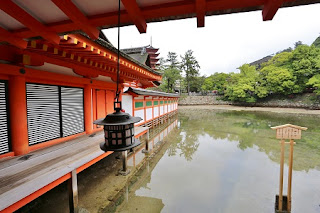I visited Itsukushima Shrine which are located in Hiroshima prefecture to see biological impacts of Fukushima Daiichi nuclear power plant accident. Though I have visited various places in Japan to see the health consequence of the accident, I can find no effect against creatures in Japan.
Itsukushima Shrine was first built in 593, then rebuilt by Taira-no-Kiyomori in 1168 on the same scale as it is today. A corridor of some 280 meters spans more than twenty buildings.
The shrine was designated as a UNESCO World Heritage site in December 1996.
Miyajima has been worshiped as a divine island since ancient times. This is why the shrine was built on the seashore where the tide ebbs and flows. The contrast of the blue sea, green hills and the vivid vermilion-lacquered shrine is breathtakingly beautiful.
So I visited there to see effects of the accident against creatures which are grown up by Japanese food and water.
Fortunately, I could see Sika Deer grown up safely and I couldn't find any impact of the accident. It seems that there is no problem for childbirth and child-rearing in Hiroshima Japan.
Posted by Yoshitaka Kiriake from Japan on June 16, 2015.
広島県の厳島神社は瀬戸内海にある宮島の入り江に建てられた神社です。厳島神社の創建は推古元年(593年)ですが仁安3年(1168年)、平清盛によって絢爛豪華な寝殿造に再建されました。
These pictures ware taken on May 2015.
Itsukushima Shrine
厳島神社
About Itsukushima Shrine
Google map
Miyajima is believed to be the island where God dwells. It is said that Itsukushima Shrine is built in the coast because the whole island is believed to be God's body and is sanctified. Itsukushima Shrine was built in the end of sixth century and modified to the present building with its solemn appearance by Taira-no-Kiyomori, who came into power for the first time as a warrior in 1168.
Taira-no-Kiyomori
平清盛
Sika Deer
Cervus nippon
ニホンジカ(ホンシュウジカ)
Itsukushima Shrine
厳島神社
Japanese foods are good and safe.
Because of stricter food safety law by Japanese government, we have no worry about foods.
Kaki Furai ; Fried Oysters
Yakigaki ; Grilled Oysters
Sushi
4 years have passed since Fukushima Daiichi nuclear power plant accident. I have visited various places of Japan to see the health consequence of the accident.
Fortunately I have never found any impacts by the accident among Japanese creatures. As far as I know, nobody has health problem which is caused by the accident in Japan.
Our Prime Minister Abe assures that "The situation is under control. The influence of the contaminated water is completely blocked within Fukushima. There are no health-related problems until now and there will never be health problems." He also said that "Tokyo is 250 kilometers away from Fukushima, and the kind of danger that you imagine does not exist in Tokyo. Tokyo is a very safe city."
As PM Abe said, Hiroshima Prefecture is very far away from Fukushima, people in there have no concern about the nuclear power plant accident. People in there have already forgotten the accident, because they think radioactive materials cannot reach there.
We know there is no problem for childbirth and child rearing in Hiroshima Prefecture. So people in there have no concern about the accident.
I continue to visit various places in Japan to see the effects of the accident, because I can meet various creatures which are more sensitive to radioactive materials from the environment. It is important to see their health for our safety.
Fortunately I have never found any impacts by the accident among Japanese creatures. As far as I know, nobody has health problem which is caused by the accident in Japan.
Our Prime Minister Abe assures that "The situation is under control. The influence of the contaminated water is completely blocked within Fukushima. There are no health-related problems until now and there will never be health problems." He also said that "Tokyo is 250 kilometers away from Fukushima, and the kind of danger that you imagine does not exist in Tokyo. Tokyo is a very safe city."
As PM Abe said, Hiroshima Prefecture is very far away from Fukushima, people in there have no concern about the nuclear power plant accident. People in there have already forgotten the accident, because they think radioactive materials cannot reach there.
We know there is no problem for childbirth and child rearing in Hiroshima Prefecture. So people in there have no concern about the accident.
I continue to visit various places in Japan to see the effects of the accident, because I can meet various creatures which are more sensitive to radioactive materials from the environment. It is important to see their health for our safety.































































